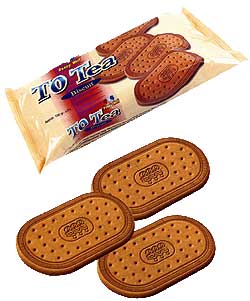The stomach is the most important part of the digestive system, consisting of four layers: the outer protective layer, the muscle layer, the smooth membrane, and the mucous membrane. The mucous membrane contains cells that secrete mucus to protect the stomach from damage by acid; however, it also has cells that secrete hydrochloric acid (HCl). Stomach ulcers occur when these cells increase acid secretion, leading to damage to the mucosa. Sometimes, acid that causes stomach inflammation can also come from external sources.
 |
|
Biscuits (Photo: Sima.egypt) |
When afflicted with this condition, in addition to medication, diet plays a crucial role in reducing the impact of acid secretion on the stomach lining.
Recommended foods: sweeteners, fats, and foods that coat the stomach lining and absorb gastric juices such as sticky rice, tapioca flour, bread, biscuits, milk, and egg whites. Soft foods have less mechanical impact; avoid hunger and overeating. It’s important to have multiple meals throughout the day, spaced 2-3 hours apart. When preparing food, it should be mashed, blended, chopped finely, or cooked thoroughly; prioritize steaming and boiling, and limit frying.
Porridge, mashed rice, bread, biscuits, sticky rice, and traditional square cakes; various types of tubers (such as potatoes, taro boiled or stewed in soup) are recommended. Other suitable dishes include minced fish and meat, steamed or braised; canned milk, fresh milk, powdered milk, butter, cheese; sugar, cakes, jams, honey, ice cream, and sweet soups. For beverages, opt for plain water or mineral water.
Avoid foods that are high in acidity (sour fruits, pickles, fermented vegetables, vinegar, and hot sauces) or that produce gas in the stomach (beans, pickled vegetables, onions), as well as foods that damage the stomach lining (such as alcohol, beer, spicy foods, garlic, coffee, and tea) or increase acid secretion (thick meat or fish sauces). Additionally, refrain from consuming fruits like bananas, papayas, apples, and processed foods like ham, sausages, and yogurt.
If you have acute gastritis, you need to give your stomach time to heal. You may need to fast for 24-48 hours because food entering the stomach stimulates acid secretion, worsening the ulcer. Only drink mineral water in moderation to avoid thirst and dehydration. After the fasting period, start with soup made with mashed vegetables and meat, drink milk, or eat ice cream with an energy intake of 1,200-1,300 Kcal. Eat small amounts each time; have multiple meals spaced an hour apart. Gradually increase the amount until symptoms such as abdominal pain, bloating, belching, and acid reflux disappear, at which point you can return to a nearly normal diet.
In cases of chronic gastritis, patients often suffer from nutritional deficiencies due to poor absorption, unable to absorb essential vitamins, particularly vitamin B12 and iron, leading to anemia. The diet should provide adequate energy and protein, with a particular emphasis on additional vitamins and minerals such as B12, folic acid, vitamins A, D, K, calcium, iron, zinc, and magnesium.
Three-Stage Diet Plan
Stage 1: Begin treatment for stomach ulcers. Only consume milk, drinking once every 1-2 hours, with each serving being about 1/3-1/2 cup (approximately 100 ml). The total energy requirement is only about 1,200 Kcal. A few days later, if there is no pain in the stomach, you can mix cream into the milk to increase energy.
Stage 2: When the stomach pain subsides, consume soft, well-cooked foods like porridge and soup, starting with 100 ml each time and gradually increasing. Aim for six meals a day, incorporating sticky rice, bread, biscuits, and minced fish and meat. Chew thoroughly for better absorption before swallowing.
Stage 3: Continue to eat 5-6 meals a day, focusing on soft, well-cooked foods.


















































